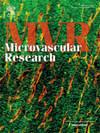Predictive value of the average three-vessel microvascular resistance in patients with non-ST-segment elevation myocardial infarction after percutaneous coronary intervention
IF 2.7
4区 医学
Q2 PERIPHERAL VASCULAR DISEASE
引用次数: 0
Abstract
Objectives
We investigated the predictive value of the average microvascular resistance of the three main vessels (3VA-AMR) for the prognosis of patients with non-ST-segment elevation myocardial infarction (NSTEMI) after percutaneous coronary intervention (PCI).
Methods
This study was conducted on patients with NSTEMI who underwent PCI between March 1, 2021, and February 28, 2022, at Fujian Medical University Union Hospital. Quantitative flow ratio (QFR) analysis was conducted on all patients' PCI angiography images to assess postoperative QFR and angio-based microvascular resistance (AMR) for three main vessels. All enrolled patients were devided into two groups based on the criteria for coronary microvascular dysfunction (CMD): high 3VA-AMR group and low 3VA-AMR group. The primary outcome was 2-year major adverse cardiac events (MACEs), including cardiovascular death, myocardial infarction, and ischemia-driven revascularization.
Results
A total of 290 patients were included in the final analysis. Compared with the low 3VA-AMR group, the three vessels of high 3VA-AMR group showed lower area stenosis (49.46 ± 13.70 % vs. 52.93 ± 15.43 %,P = 0.001), higher QFR value (0.92 ± 0.05 vs. 0.88 ± 0.09, P < 0.001), and higher AMR value (274.50 [257.33–301.42] mmHg*s/m vs. 208.00 [182.00–231.83] mmHg*s/m, P < 0.001). The incidence of 2-year MACEs was significantly higher in the high 3VA-AMR group than in the low 3VA-AMR group (21.90 % vs. 10.27 %, P = 0.007). Univariate and multivariate Cox regression analyses confirmed that 3VA-AMR was independently associated with 2-year MACEs (HR:1.007, 95 % CI:1.004–1.010, P < 0.001). The Kaplan–Meier method further confirmed the difference in 2-year MACE risk between two groups. Receiver operating characteristic curve analysis showed a significant correlation between 3VA-AMR and MACE (area under the curve: 0.701, P < 0.001).
Conclusions
3VA-AMR was an independent risk factor for 2-year MACEs in NSTEMI patients. Compared with target-vessel AMR, 3VA-AMR demonstrated superior predictive value for 2-year MACEs following PCI.
非st段抬高型心肌梗死经皮冠状动脉介入治疗后平均三支微血管阻力的预测价值。
目的:探讨三主血管平均微血管阻力(3VA-AMR)对经皮冠状动脉介入治疗(PCI)后非st段抬高型心肌梗死(NSTEMI)患者预后的预测价值。方法:本研究于2021年3月1日至2022年2月28日在福建医科大学协和医院行PCI的NSTEMI患者进行。对所有患者PCI血管造影图像进行定量血流比(QFR)分析,评估术后三条主要血管的QFR和血管微血管阻力(AMR)。所有入组患者根据冠状动脉微血管功能障碍(CMD)标准分为高3VA-AMR组和低3VA-AMR组。主要终点是2年主要不良心脏事件(mace),包括心血管死亡、心肌梗死和缺血驱动的血运重建术。结果:290例患者纳入最终分析。与低3VA-AMR组相比,高3VA-AMR组三支血管狭窄程度较低(49.46 ± 13.70 %比52.93 ± 15.43 %,P = 0.001),QFR值较高(0.92±0.05比0.88±0.09,P < 0.001), AMR值较高(274.50 [257.33-301.42]mmHg*s/m比208.00 [182.00-231.83]mmHg*s/m, P < 0.001)。高3VA-AMR组2年mace发生率显著高于低3VA-AMR组(21.90 % vs. 10.27 %,P = 0.007)。单因素和多因素Cox回归分析证实3VA-AMR与2年mace独立相关(HR:1.007, 95 % CI:1.004-1.010, P )结论:3VA-AMR是NSTEMI患者2年mace的独立危险因素。与靶血管AMR相比,3VA-AMR对PCI术后2年mace的预测价值更高。
本文章由计算机程序翻译,如有差异,请以英文原文为准。
求助全文
约1分钟内获得全文
求助全文
来源期刊

Microvascular research
医学-外周血管病
CiteScore
6.00
自引率
3.20%
发文量
158
审稿时长
43 days
期刊介绍:
Microvascular Research is dedicated to the dissemination of fundamental information related to the microvascular field. Full-length articles presenting the results of original research and brief communications are featured.
Research Areas include:
• Angiogenesis
• Biochemistry
• Bioengineering
• Biomathematics
• Biophysics
• Cancer
• Circulatory homeostasis
• Comparative physiology
• Drug delivery
• Neuropharmacology
• Microvascular pathology
• Rheology
• Tissue Engineering.
 求助内容:
求助内容: 应助结果提醒方式:
应助结果提醒方式:


